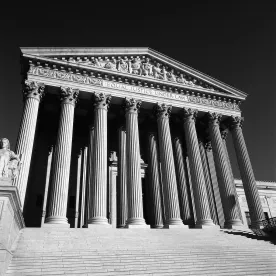On April 17, 2012, the U.S. Supreme Court issued a unanimous decision delivered by Justice Kagan in Caraco Pharmaceutical Laboratories Ltd. v. Novo Nordisk A/S, reversing the Federal Circuit and holding that a generic manufacturer (Caraco) may force correction of an Orange Book use code that inaccurately describes a brand company’s (Novo’s) patent as covering a particular method of using the drug in question under 21 U.S.C. §355(j)(5)(C)(ii)(I) (“the counterclaim provision”). Justice Kagan’s opinion was accompanied by a concurring opinion by Justice Sotomayor.
As background, when submitting a New Drug Application (“NDA”), an innovator (or “brand”) pharmaceutical company must identify any patents that claim the drug that is the subject of the application or any method of using such drug. Once the NDA is approved, the FDA publishes the patent information in a database commonly known as the “Orange Book.” Specifically for patents that claim a method of use, the FDA requires that the NDA holder provide a description of the relevant claimed subject matter (“use code”), for which the FDA then assigns a use code number based on that description. A drug product may be approved for multiple uses and have more than one use code.
FDA’s patent use codes play an important role in the Hatch-Waxman statutory scheme. When a method of use patent is listed in the Orange Book, a prospective generic applicant (i.e., “ANDA applicant”) has one of two options if it wishes to obtain marketing approval prior to the expiration of that patent: first, it may submit a so-called section viii statement, which means that the generic applicant only seeks approval for one or more methods of use not covered by the listed patent, or second, it may file a so-called paragraph IV certification, which means that the generic applicant seeks approval for all methods of use, including any that are claimed by the patent. When submitting a section viii statement, the generic applicant “carves-out” portions of its label that recite the patented use. Importantly, a section viii statement does not give rise to litigation, but a paragraph IV certification does. The scope of the patent use code determines whether the FDA will allow a generic applicant to submit a section viii statement or not. The FDA will not allow a section viii statement if the generic’s proposed carve-out label has any overlap with the brand’s use code.
In Caraco, the brand drug product (repaglinide) has three approved uses for treating diabetes: (1) repaglinide monotherapy; (2) repaglinide in combination with thiazolidinediones; and (3) repaglinide in combination with metformin. Novo listed the ‘358 patent in the Orange Book, which claims the use of repaglinide in combination with metformin, only one of the approved uses for repaglinide. The other two uses—repaglinide monotherapy or in combination with thiazolidinediones — are unpatented. Initially, the use code narrative corresponding to the ‘358 patent recited the “[u]se of repaglinide in combination with metformin to lower blood glucose,” consistent with the claim scope. In its ANDA, Caraco submitted a section viii statement as to the ‘358 patent and “carved out” the patented combined use with metformin. Novo then amended the use code and broadened it to recite “[a] method for improving glycemic control in adults with type 2 diabetes.” As amended, the use code encompassed (i.e., “overlapped”) the unpatented uses as well as the combined use with metformin claimed in the ‘358 patent. Because of the overlap, the FDA rejected Caraco’s section viii statement and corresponding labeling carve out.
21 U.S.C. §355(j)(5)(C)(ii)(I) authorizes an ANDA applicant sued for patent infringement to “assert a counterclaim seeking an order requiring the [brand] to correct or delete the patent information submitted by the [brand] under subsection (b) or (c) [of §355] on the ground that the patent does not claim either— (aa) the drug for which the [brand’s NDA] was approved; or (bb) an approved method of using the drug.”
After being sued by Novo, Caraco asserted a counterclaim seeking an order requiring the brand to correct the use code, i.e., to change it back to the previous use code that tracked the claim language of treating diabetes by administering repaglinide in combination with metformin. The district court granted summary judgment to Caraco, enjoining Novo to “correct . . . its inaccurate description of the ‘358 patent [i.e., the patent with claims directed to treating diabetes using repaglinide in combination with metformin].” The Federal Circuit held that use codes are not subject to correction by counterclaim and reversed. The Supreme Court in turn reversed the Federal Circuit and remanded, holding that Caraco may force correction of the overly broad use code under the statute. In addition, the Supreme Court states that the statute language “under subsection (b) or (c)” should be given a broad meaning and includes “information to other patent materials the FDA demands in the regulatory process.” The Court’s statement indicates that a counterclaim may be available to generic companies in Hatch-Waxman litigations to seek an order requiring the brand company to correct or delete patent material or information, in addition to use codes.
The decision in Caraco v. Novo is likely to have an impact on both brand and generic companies in Orange Book use code listing and challenging strategies. For example, brand companies will have an incentive to obtain patents with broad method of use claims such that a broad use code narrative can be drafted, making section viii carve outs more difficult. On the other hand, the decision makes clear that generic companies can counterclaim to challenge the accuracy of use codes.
The Court’s decision may also prompt the FDA to clarify its guidance to the industry regarding use codes. Justice Sotomayor commented in her concurring opinion that “FDA’s guidance as to what is required of brand manufacturers in use codes [is] remarkably opaque,” and that the litigation arose “in some aspects because of FDA’s opacity in describing what is required of brand manufacturers.” It will be interesting to see if the FDA provides clearer guidance in response to these remarks.






 />i
/>i
